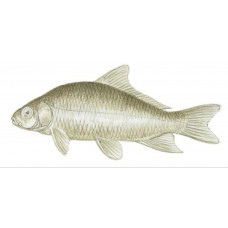Latin name
Ictiobus bubalus
Other names
Azorback buffalo, roachback, thick-lipped buffalo, channel buffalo, humpbacked buffalo, high-back buffalo, river buffalo.
Identification
A deep-bodied and compressed fish, the smallmouth buffalo has a small conical head, a high back, and a long dorsal fin. It also has a small, thick-lipped mouth with distinct grooves on the upper lip. The upper jaw is considerably shorter than the snout. The coloration is usually lighter than that of other buffalo: the back is gray, olive, or bronze, the sides are black to olive-yellow, the belly is white to yellow, and it has an olive-bronze sheen. The pelvic fins are olive or grayish black, and the rest of the fins are indistinctly dark. It bears a marked resemblance to the bigmouth buffalo, but can be distinguished by its more compressed body and more steeply curved back. It also has a smaller, subterminal mouth located laterally. The bigmouth buffalo has its mouth located obliquely. It is characteristic of all suckers that the mouth expands downward, this is when the fish is feeding.
Distribution
Found only in North America, the smallmouth buffalo has a range similar to that of the bigmouth buffalo. It is found in the Lake Michigan drainage and the Mississippi River basin, from Pennsylvania and Michigan to Montana and south to the Gulf of Mexico, and from Mobile Bay, Alabama, west to the Rio Grande in Texas and New Mexico. It also occurs in Mexico and has been introduced into Arizona. Likewise, it is most abundant in the central states.
Habitat
Smallmouth buffalo inhabit pools, dams, large streams, and the main channels of small and large rivers, as well as warm lakes and reservoirs. They prefer cleaner and deeper waters than bigmouth buffalo, which explains their relatively smaller numbers.
Size
Growing slower than bigmouth, smallmouth buffalo can reach 36 inches in length. The average size of fish caught commercially ranges from 2 to 10 pounds, although some specimens reach 15 to 20 pounds. The world record for catching smallmouth buffalo is 82 pounds 3 ounces.
Life history and Behavior
Spawning and schooling habits are similar or identical to bigmouth buffalo.
Food and feeding habits
Smallmouth buffalo feed on mollusks and algae, crushing them with bone plates in their throats designed for that purpose. They eat more insects and bottom organisms than bigmouth buffalo.
Reproduction
No information
| Classification | |
| Phylum | Chordata |
| Class | Actinopterygii |
| Squad | Cypriniformes |
| Family | Catostomidae |
| Genus | Ictiobus |
| Species | I. bubalus |
| Features | |
| Conservation status | Least Concern |
| Habitat | Pelagic |
| Life span, years | No information |
| Maximum body weight, kg | 40 |
| Maximum length, cm | 101.5 |
| Sailing speed, m/s | No information |
| Threat to people | Edible |
| Way of eating | Predator |
Buffalo, Smallmouth
Tags: Buffalo, Smallmouth

